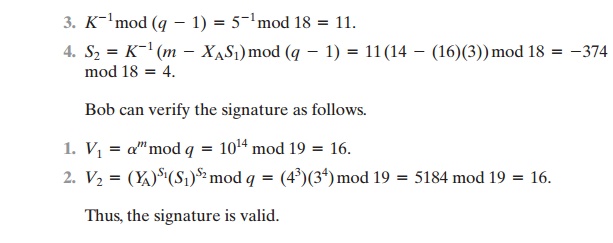Chapter: Cryptography and Network Security Principles and Practice : Cryptographic Data Integrity Algorithms : Digital Signatures
ELGAMAL Digital Signature Scheme
ELGAMAL DIGITAL SIGNATURE SCHEME
Before examining the NIST Digital
Signature standard, it will be helpful to under-
stand the ElGamal and Schnorr
signature schemes. Recall
from Chapter 10, that the ElGamal encryption scheme is designed to enable encryption by a user’s public key with decryption by the user’s private key. The ElGamal signature scheme involves the use of the
private key for encryption
and the public key for decryption [ELGA84, ELGA85].
Before proceeding, we need a result from number theory. Recall
from Chapter 8 that
for a prime number q, if a is a primitive
root of q, then

are distinct (mod q). It can be shown that, if a is a primitive root of q,
then

As with ElGamal
encryption, the global
elements of ElGamal digital signature are
a prime number q and a, which is a primitive root of q. User A generates a private/public key pair as follows.
1.
Generate a random
integer XA, such that 1 6 XA<q - 1.
2.
Compute YA = aXA mod q.
3.
A’s private key is XA; A’s pubic key is {q, a, YA}.
To sign a message M, user A first computes the hash m = H(M), such that m is an integer in the range 0 <= m <= q - 1. A then forms a
digital signature as follows.
1.
Choose a random
integer K such that 1 <= K <= q - 1 and gcd(K, q - 1) = 1. That is, K is
relatively prime to q - 1.
2.
Compute S1 = aKmod q. Note that this is
the same as the computation of C1
for ElGamal encryption.
3.
Compute K- 1mod (q - 1). That is, compute the
inverse of K modulo
q
- 1.
4.
Compute S2 = K- 1(m - XAS1) mod (q - 1).
5.
The signature consists of the pair (S1, S2). Any user B can verify the signature
as follows.
1.
Compute V1 = am mod q.
2.
|
The signature is valid if V1 = V2. Let us demonstrate that this is so. Assume that the
equality is true. Then we have

For example, let us start with the prime
field GF(19); that is, q = 19. It has
primitive roots {2, 3, 10, 13, 14, 15}, as shown in Table 8.3. We choose a = 10.
Alice generates a key pair as follows:
1.
Alice chooses XA = 16.
2.
Then YA = aXA mod q
= a16 mod 19 = 4.
3.
Alice’s private key is 16; Alice’s pubic key is {q, a,
YA} = {19, 10, 4}.
Suppose Alice wants to sign a message
with hash value m = 14.
1.
Alice chooses K = 5,
which is relatively prime to q - 1 = 18.
2.
S1 = aKmod q = 105mod 19 = 3 (see Table 8.3).

Related Topics